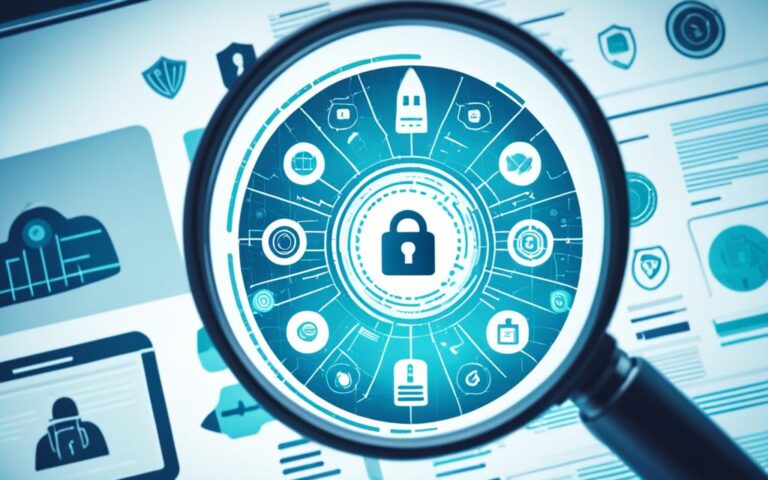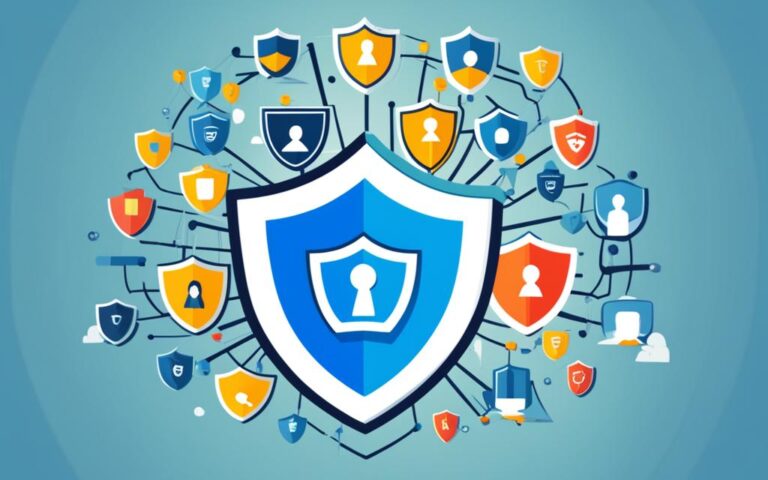Ransomware Eradication: Lessons from Major Attacks
Ransomware attacks are a significant threat to cybersecurity, and it is important to learn from major attacks to protect networks effectively. This article explores the lessons learned from past ransomware attacks and provides valuable insights for safeguarding networks in the UK.
In a digital landscape where cyber threats are constantly evolving, it is crucial for organizations in the United Kingdom to stay updated and proactive in combating ransomware. The devastation caused by major attacks has become a wake-up call for businesses, highlighting the pressing need for robust cybersecurity measures.
By examining the lessons learned from these high-profile incidents, organizations can gain valuable insights into the methods employed by hackers and identify vulnerabilities in their own networks. Armed with this knowledge, they can fortify their defenses, protect sensitive data, and minimize the impact of future attacks.
Cybersecurity is not a one-time solution; it requires continuous vigilance and an adaptable approach. In this article, we will delve into the intricacies of the ransomware business, understanding the motivations that drive cybercriminals and how organizations can develop effective strategies to counter these threats.
Stay tuned for actionable insights and expert advice on how to strengthen your network’s security and protect your organization from the ever-growing ransomware menace.
Understanding the Business of Ransomware
Ransomware has evolved into a highly profitable business, constantly threatening organizations worldwide. To effectively combat this menace, it is paramount to comprehend the nature of ransomware attacks and the motivations driving these criminal activities. By gaining insights into the inner workings of the ransomware business, organizations can develop robust cybersecurity strategies to safeguard their valuable assets.
The Lucrative Ransomware Business
At its core, the ransomware business operates on a simple yet potent model – cybercriminals gain unauthorized access to systems, encrypt crucial data, and demand a ransom in exchange for its release. This business model has proven immensely successful, with cybercriminals pocketing millions of pounds from their victims.
“The rise of cryptocurrencies has provided ransomware criminals with an efficient and anonymous means of collecting payments, leading to a surge in ransomware attacks.”
Unlike traditional criminal enterprises, the ransomware business boasts low overhead costs and minimized operational risks. Cybercriminals can leverage readily available hacking tools and exploit vulnerabilities in outdated systems or unsuspecting individuals, maximizing their chances of success.
Motivations and Ransomware Threats
Understanding the motivations behind ransomware attacks is vital in formulating effective cybersecurity measures. Financial gain remains the primary driving force, with cybercriminals targeting organizations of all sizes, from small businesses to multinational corporations.
However, there are additional motivations beyond monetary gain. Some cybercriminals may engage in ransomware attacks for ideological reasons, seeking to disrupt critical infrastructure or cause widespread panic. State-sponsored actors also use ransomware as a tool for political or economic espionage, further complicating the threat landscape.
The Expanding Arsenal of Ransomware Threats
Ransomware threats are continually evolving, with cybercriminals employing advanced techniques to maximize their profitability. Traditional forms of ransomware, such as encrypting files, have now been supplemented with more insidious tactics, including exfiltration of sensitive data and threats to leak it to the public or sell it on the dark web.
As organizations bolster their cybersecurity defenses, ransomware threat actors adapt by targeting vulnerabilities in backup systems, rendering them useless in the event of an attack. This added layer of complexity necessitates comprehensive security protocols and robust backup strategies to thwart these evolving threats.
| Ransomware Threats | Impact |
|---|---|
| Data Encryption | Disruption of business operations, loss of critical data |
| Data Exfiltration | Potential leak of sensitive information, reputational damage |
| Backup Targeting | Compromised data recovery capabilities, extended downtime |
The ever-changing landscape of ransomware demands a proactive approach to cybersecurity. By staying abreast of emerging threats and adopting robust security measures, organizations can effectively combat ransomware attacks, protecting their valuable assets and maintaining business continuity.
Lessons Learned from Ransomware Attacks
Analyzing previous ransomware attacks provides valuable insights into identifying common patterns and understanding the strategies employed by cybercriminals. By learning from these experiences, organizations can enhance their cybersecurity measures, prepare for future attacks, and implement best practices to mitigate the risks effectively.
The following are ten important lessons learned from ransomware attacks:
- Preparedness is Key: Being proactive and prepared is crucial in safeguarding against ransomware attacks. Organizations should develop robust incident response plans and conduct regular drills to ensure readiness.
- Limitations of Technology: While technology plays a crucial role in cybersecurity, it is important to recognize its limitations. Implementing advanced security measures is necessary, but they should be complemented by comprehensive strategies that involve people, processes, and technology.
- Comprehensive Planning: A well-rounded approach to cybersecurity should include investing in preventive measures, such as robust firewalls and antivirus software, as well as proactive threat intelligence and employee awareness programs.
- Backup and Recovery Strategies: Having secure and independent backups is crucial in recovering from a ransomware attack. Regularly testing the restoration process ensures that backups are reliable and ready for use when needed.
- Segmentation of Networks: Segmenting networks helps contain the spread of ransomware by limiting its impact to specific areas. This practice is particularly effective in preventing lateral movement and minimizing potential damage.
- Employee Education: Employees are often the weakest link in cybersecurity. Providing comprehensive training on recognizing phishing emails, practicing good password hygiene, and maintaining awareness of potential threats can significantly reduce the risk of compromise.
- Continuous Monitoring: Implementing robust monitoring and detection systems can help identify ransomware attacks in their early stages, allowing for a prompt response and containment.
- Vulnerability and Patch Management: Regularly updating and patching systems and applications is crucial in addressing known vulnerabilities that cybercriminals may exploit.
- Collaboration and Information Sharing: Sharing threat intelligence and collaborating with industry peers and government agencies can help organizations stay ahead of evolving ransomware threats.
- Post-Incident Analysis: Conducting thorough post-incident analysis allows organizations to identify gaps in their cybersecurity defenses, refine incident response plans, and enhance their overall security posture.
By implementing these lessons, organizations can strengthen their cybersecurity defenses, minimize the impact of ransomware attacks, and better protect their sensitive data and critical systems.
The Importance of Preparedness
One of the most critical lessons learned from ransomware attacks is the importance of preparedness. Organizations that invest in proactive measures and develop comprehensive incident response plans are better equipped to detect, respond to, and recover from ransomware attacks. Preparedness involves:
- Regular vulnerability assessments and penetration testing to identify and address weaknesses.
- Implementing a robust backup strategy that includes secure and offsite storage.
- Conducting thorough employee training on cybersecurity best practices and recognizing potential threats.
- Establishing clear communication channels and assigning roles and responsibilities during an incident.
- Regularly updating and testing incident response plans to ensure effectiveness and alignment with the latest threats.
By prioritizing preparedness, organizations can mitigate the impact of ransomware attacks and significantly reduce the risk of data loss, financial loss, and reputational damage.
| Lesson | Description |
|---|---|
| Preparedness is Key | Being proactive and prepared is crucial in safeguarding against ransomware attacks. Organizations should develop robust incident response plans and conduct regular drills to ensure readiness. |
| Limitations of Technology | While technology plays a crucial role in cybersecurity, it is important to recognize its limitations. Implementing advanced security measures is necessary, but they should be complemented by comprehensive strategies that involve people, processes, and technology. |
| Comprehensive Planning | A well-rounded approach to cybersecurity should include investing in preventive measures, such as robust firewalls and antivirus software, as well as proactive threat intelligence and employee awareness programs. |
| Backup and Recovery Strategies | Having secure and independent backups is crucial in recovering from a ransomware attack. Regularly testing the restoration process ensures that backups are reliable and ready for use when needed. |
| Segmentation of Networks | Segmenting networks helps contain the spread of ransomware by limiting its impact to specific areas. This practice is particularly effective in preventing lateral movement and minimizing potential damage. |
The Evolving Tactics of Ransomware Threat Actors
Ransomware threat actors are continually adapting their tactics to maximize profits and exploit vulnerabilities in organizations’ systems. They employ sophisticated methods to evade detection and make it increasingly challenging for victims to recover their data. This section explores some of the evolving tactics employed by ransomware threat actors, including the targeting of backups and the utilization of data exfiltration as a ransomware strategy.
Targeting Backups
Ransomware threat actors have shifted their focus to targeting backups as a means to undermine an organization’s ability to restore their data independently. By gaining access to backup systems, threat actors can delete or encrypt vital backups, preventing victims from recovering their information seamlessly. This tactic enhances their leverage during negotiations and increases the likelihood of victims succumbing to payment demands.
Organizations must prioritize the security of their backup systems and implement robust access controls, multi-factor authentication, and regular integrity checks. This will help mitigate the risk of threat actors infiltrating and compromising the backup infrastructure.
Data Exfiltration as a Ransomware Strategy
Another concerning trend in ransomware attacks is the increasing use of data exfiltration as a strategy to coerce victims into paying the ransom. Threat actors often compromise organizations’ networks and exfiltrate sensitive data before encrypting it. They then threaten to leak or sell the stolen data if the ransom is not paid, putting victims at risk of reputation damage and regulatory penalties.
This tactic places additional pressure on organizations to comply with the ransom demands, as the potential impact of data leakage or exposure becomes a significant concern. To counter this tactic, organizations should implement strong data loss prevention measures, regularly back up their data offline and securely, and encrypt sensitive information to minimize the risk of unauthorized access.
“Ransomware threat actors are continually evolving their tactics to target both the operational and reputational aspects of an organization. By staying informed and adopting proactive cybersecurity measures, organizations can better protect themselves from the devastating consequences of ransomware attacks.” – Cybersecurity Expert
| Ransomware Threat Actors Tactics | Impact |
|---|---|
| Targeting backups | Prevents independent data recovery, increases leverage during negotiations |
| Data exfiltration | Threatens data leakage or exposure, increases pressure to pay ransom |
| Sophisticated evasion techniques | Heightened difficulty in detecting and mitigating ransomware attacks |
| Customized ransom amounts | Increases the likelihood of payment by tailoring demands to the victim’s capabilities |
The Challenges of Recovery in Ransomware Attacks
Recovering from a ransomware attack can be an arduous and complex process. Organizations face numerous challenges in regaining access to their systems and data, requiring careful planning and strategic approaches. In this section, we will explore the key challenges that organizations encounter during the recovery phase of a ransomware attack.
“The recovery process after a ransomware attack can be like navigating through a maze. It requires a systematic approach and a deep understanding of the complexities involved.” – Cybersecurity Expert
The Need for Forensic Imaging
Forensic imaging plays a vital role in recovering from a ransomware attack. It involves creating a complete and accurate copy of the compromised system for analysis and investigation. This step is crucial in understanding the scope of the attack, identifying the entry point, and assessing the extent of the damage. Forensic imaging aids in forensic analysis, facilitates legal proceedings, and helps organizations strengthen their security infrastructure.
Insurance Companies and Their Involvement
Many organizations have insurance policies that cover ransomware attacks. In such cases, involving insurance companies becomes an integral part of the recovery process. Insurance providers may have specific protocols and requirements for validating and documenting the attack, assessing the damages, and approving financial reimbursement. Coordinating with insurance entities adds another layer of complexity to the already challenging recovery process.
Time Required for Hardware Readiness
Restoring systems and ensuring hardware readiness is a time-consuming aspect of the recovery process. It involves repairing or replacing compromised hardware components, such as servers, routers, and storage devices. Procuring and configuring new hardware, or restoring the affected hardware, demands meticulous planning and execution. This critical phase can cause significant delays in fully recovering from a ransomware attack.
Establishing redundant infrastructure and disaster recovery plans plays a pivotal role in mitigating the challenges of recovery. Having backup systems and regularly testing them ensures that organizations can quickly recover their operations and minimize downtime in the event of a ransomware attack.
By understanding the recovery challenges associated with ransomware attacks, organizations can develop effective strategies to strengthen their resilience and minimize the impact of future incidents. It is essential to stay proactive, continuously assess and update security measures, and invest in robust cybersecurity solutions to safeguard against the ever-evolving ransomware threat landscape.
Reinfection Risk and Recovery Discipine
During the recovery process from a ransomware attack, one of the most critical considerations is mitigating the risk of self-reinfection. Without proper recovery discipline, organizations may inadvertently leave their systems vulnerable to another attack. This section highlights the importance of maintaining strict recovery discipline and following proper protocols to safeguard against self-reinfection.
The Risk of Self-Reinfection
Self-reinfection occurs when an organization’s systems are compromised again shortly after recovering from a ransomware attack. This can happen if proper precautions are not taken, such as failing to identify and address the root cause of the initial attack or neglecting to update security measures.
In some cases, self-reinfection can be triggered by residual malware left behind during the recovery process. Ransomware can hide in various places within an organization’s network, making it challenging to completely eliminate the threat without thorough investigation and remediation.
Maintaining Recovery Discipline
To prevent self-reinfection, it is crucial for organizations to maintain rigorous recovery discipline. This involves adhering to a structured recovery plan and implementing the following measures:
- Isolate Infected Systems: Immediately isolate and disconnect infected systems from the network to prevent the spread of ransomware and further compromise.
- Perform a Risk Assessment: Conduct a comprehensive risk assessment to identify vulnerabilities and determine the root cause of the initial attack.
- Implement Security Updates: Patch and update all software and operating systems to address any known vulnerabilities that could be exploited by ransomware.
- Scan and Remove Residual Malware: Perform thorough scans of all systems and devices to detect and remove any residual malware that may have been left behind.
- Implement Network Segmentation: Separate critical systems and data from general network access to minimize the impact of any future attacks and contain the spread of ransomware.
Network Security Measures
Reinforcing network security is an integral part of recovery discipline to prevent self-reinfection. Investing in robust and comprehensive network security measures helps to protect against future ransomware threats. Organizations should consider implementing the following strategies:
- Firewalls and Intrusion Detection Systems: Deploy firewalls and intrusion detection systems to monitor and filter network traffic, blocking unauthorized access and suspicious activities.
- Endpoint Protection: Utilize endpoint protection software to detect and block malicious activities on individual devices connected to the network.
- Regular Data Backups: Implement regular and automated data backups to secure critical information and ensure rapid recovery in the event of another attack.
- Employee Training and Awareness: Educate employees about the importance of network security, ransomware threats, and safe online practices to reduce the risk of human error leading to reinfection.
By prioritizing recovery discipline and fortifying network security, organizations can significantly reduce the self-reinfection risk and minimize the potential impact of future ransomware attacks.
Summary
In this section, we explored the importance of recovery discipline and network security in mitigating the risk of self-reinfection after a ransomware attack. Maintaining strict recovery discipline involves isolating infected systems, performing risk assessments, implementing security updates, scanning and removing residual malware, and implementing network segmentation. Additionally, organizations should invest in network security measures such as firewalls, intrusion detection systems, endpoint protection, regular data backups, and employee training to protect against future attacks. By following these best practices, organizations can reduce the likelihood of self-reinfection and strengthen their overall cybersecurity measures.
Conclusion
Ransomware attacks continue to pose a significant threat to organizations worldwide. The lessons learned from major attacks provide valuable insights into strengthening cybersecurity strategies and protecting networks effectively. Implementing cybersecurity best practices and staying vigilant are crucial steps in mitigating the risks associated with ransomware attacks.
One of the major lessons learned is the importance of preparedness. Organizations must prioritize regular backups, ensure they are properly secured, and test their restoration processes. Additionally, it is essential to invest in robust network security solutions, such as firewalls, intrusion detection systems, and endpoint protection software, to detect and prevent ransomware attacks.
Another crucial aspect is employee education. Training staff members on cybersecurity best practices, such as identifying phishing emails and practicing safe browsing habits, can significantly reduce the likelihood of successful ransomware attacks. Regular security awareness programs can empower employees to recognize and report suspicious activities, strengthening the overall defense against ransomware threats.
By applying these lessons, organizations can enhance their resilience to ransomware attacks and minimize the potential damage caused. Protecting networks and data integrity requires a proactive approach that combines advanced technology tools, employee education, and a robust incident response plan. In an ever-evolving threat landscape, maintaining up-to-date cybersecurity measures is key to safeguarding against ransomware and other cyber threats.












